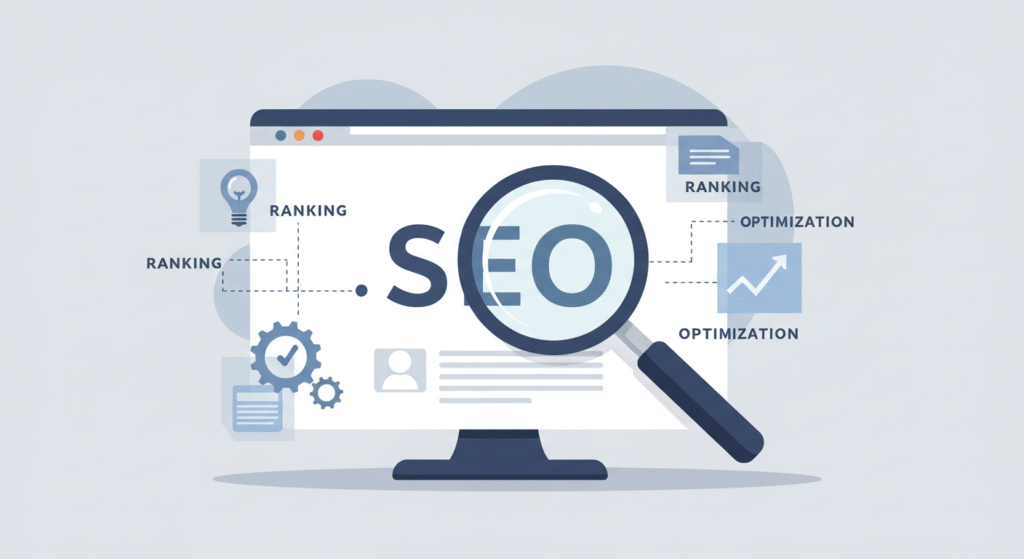Introduction: Why You’re Here (and Why SEO Feels Like Magic at First)
Imagine this: you’ve poured your heart into creating a shiny new website, published blog posts, maybe uploaded a few product pages—and then… crickets. No one visits. No one clicks. And you find yourself whispering to the internet gods: “How do I make people actually find this?”
That is where SEO—Search Engine Optimization—comes into play. SEO is the art and science of making your site discoverable when someone Googles a question, searches on Bing, or even asks an AI assistant. It’s about matching what people are looking for with what you provide… and convincing search engines that your site deserves a prominent spot.
In this beginner-friendly guide, you’ll learn what SEO actually is (without the jargon headache), why it matters, and practical steps to start ranking better in Google and beyond. We’ll cover on-page strategies, technical must‑dos, content optimization, off‑page authority building, plus some current trends. By the time you finish, you won’t feel intimidated by SEO—you’ll feel empowered.
Grab your metaphorical climbing gear: we’re scaling the search engine results page together.
What Is SEO? The Simple Definition
At its core: SEO stands for Search Engine Optimization.
It’s the process of improving your website so it:
- Ranks higher on search engines
- Attracts the right visitors
- Drives organic (free) traffic
Think of search engines like huge libraries. Every page on the web is a “book,” and SEO is how you make sure your book gets cataloged correctly, gets displayed in the right aisle, and ideally ends up face-out on the front shelf where curious readers actually see it.
Why SEO Matters for Beginners
- Most online journeys start with search. Google handles over 8.5 billion searches per day.
- Organic traffic compounds. Paid ads vanish when your budget dries up. SEO continues to deliver.
- Credibility boost. High rankings signal trust and authority to users.
In other words: if you want visibility, trust, and conversions, you can’t ignore SEO.
How Search Engines Work
Before diving into tactics, let’s peek behind the curtain. Search engines follow three key steps:
- Crawling → Bots (a.k.a. spiders) scan websites across the web.
- Indexing → The scanned content is stored and organized in giant databases.
- Ranking → Algorithms decide which pages are most relevant and should appear at the top.
Search engines evaluate hundreds of ranking signals—everything from keyword relevance to page speed to backlinks. While Google guards the full recipe like Coca-Cola, we know the main ingredients.
The Three Pillars of SEO
1. On-Page SEO
This is everything you do on your site to improve visibility:
- Optimizing titles, meta descriptions, and headings
- Using keywords naturally in content
- Writing for humans first (but signaling to bots clearly)
- Internal linking to help users and bots explore related pages
- Adding alt text and descriptive filenames to images
Think of on-page SEO as your site’s “resume”—clearly presenting its skills and expertise.
2. Technical SEO
This ensures search engines can properly crawl and index your site. Important factors:
- Mobile-friendliness (responsive design is non-negotiable)
- Fast page speed (because nobody likes a slow site)
- Secure browsing (HTTPS beats HTTP every time)
- Clean site architecture and XML sitemaps
- Fixing crawl errors and broken links
If on-page SEO is the resume, technical SEO is making sure HR can actually read and process it.
3. Off-Page SEO
This is the reputation-building side of SEO, largely about backlinks—other sites linking to you. It also includes:
- Brand mentions
- Social signals
- Guest posting
- Digital PR efforts
The idea: if trusted sites vouch for you, search engines trust you more.
Beginner’s Roadmap: How to Start With SEO (Step-by-Step)
If you’re new, don’t panic. SEO boils down to consistent basics. Here’s a no-fluff action plan:
1: Keyword Research
- Use tools like Google Keyword Planner, Ubersuggest, or SEMrush
- Focus on long-tail keywords: “best budget running shoes for flat feet” beats “shoes”
- Map keywords to specific pages (avoid keyword cannibalization)
2: Optimize On-Page Elements
- Title tags: under 60 characters, keyword at the front
- Meta descriptions: entice clicks, include keywords naturally
- H1 + H2 hierarchy: structure content clearly
- Sprinkle semantic keywords (related terms like “search ranking,” “organic traffic,” “Google SEO”)
3: Create Content That Truly Helps
- Answer questions better than your competitors
- Use bullet points and lists so content is scannable
- Incorporate visuals, diagrams, examples
4: Improve Technical SEO
- Audit with Google Search Console
- Compress images for faster load time
- Use schema markup (rich snippets help click-through rates)
5: Build Off-Page Authority
- Guest post on relevant blogs
- Get listed in reputable directories
- Offer link-worthy resources (like infographics or research)
6: Track & Adjust
- Monitor rankings in Google Search Console
- Track traffic via Google Analytics
- Refine strategy based on results
Common Beginner Mistakes to Avoid
- Keyword stuffing (“SEO SEO SEO best SEO tips for SEO success”… please don’t).
- Ignoring technical health (broken links, slow site, no HTTPS).
- Forgetting user intent—ranking for a keyword doesn’t matter if it doesn’t attract the right audience.
- Skipping analytics (flying blind).
SEO Best Practices That Stand the Test of Time
- Create genuinely valuable content. (Think “helpful teacher,” not “pushy marketer.”)
- Keep your site technically healthy.
- Earn links by being a resource, not by spamming.
- Optimize for humans first, algorithms second.
SEO Trends to Watch
- Voice search optimization: People search with full sentences (“What’s the best coffee near me?”).
- AI in search (Google’s SGE): Content that answers clearly and directly wins.
- Video SEO: YouTube is the second-largest search engine.
- E-E-A-T importance: Content that shows real expertise and experience is rewarded.
FAQs About SEO (Answer-Engine Optimized)
1. What does SEO mean in simple terms?
SEO means improving your website so it shows up higher in Google and other search engines. It’s how people find your content without you paying for ads.
2. How long does SEO take to work?
Usually between 3 to 6 months to see noticeable results—though timing depends on competition, niche, and effort.
3. Do I need to hire an SEO expert as a beginner?
Not necessarily. With free tools and guides like this one, beginners can handle many basics. An expert becomes valuable for scaling or fixing deep technical issues.
4. What’s the difference between SEO and paid ads?
Paid ads deliver instant traffic but vanish when the budget ends. SEO takes longer but builds long-term, sustainable visibility.
5. Is SEO dead in 2025?
Nope. SEO evolves continuously, but as long as people search for things, optimizing for search remains essential.
6. Can AI replace SEO?
AI changes how people search, but it won’t replace SEO. Instead, SEO adapts—focusing on creating clear, helpful content that AI and humans both trust.
Conclusion: Your SEO Journey Starts Now
SEO isn’t sorcery—it’s strategy plus consistency. You now know what SEO is, how it works, the pillars that support it, and a practical roadmap to start optimizing your own website. If you keep one thing in mind, let it be this: focus on helping real people, and search engines will reward you.
So take your first step: pick a keyword, optimize a page, or check your site speed today. Each small effort builds momentum. And before long, you’ll find your site climbing those search rankings—proof that your hard work is paying off.
If this guide gave you clarity, share it with a fellow beginner, leave a comment with your biggest SEO “aha” moment, or subscribe to keep leveling up your digital skills.
Happy ranking, future SEO pro. 🚀

